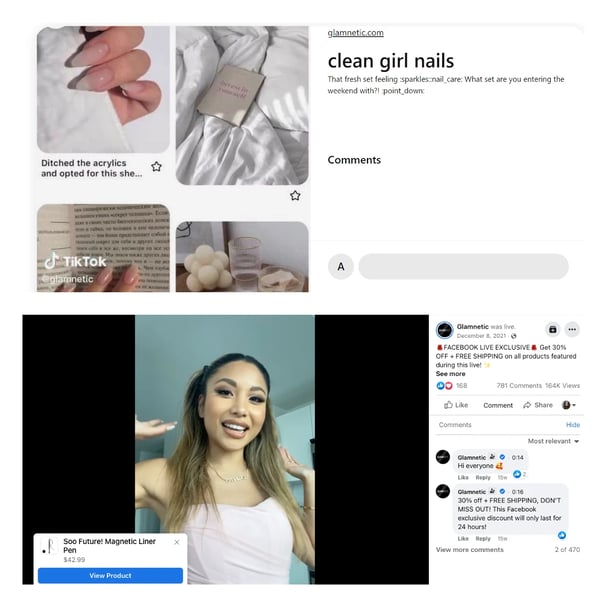5 Social Commerce Best Practices + Examples To Inspire You
Its widely known that convenience is the key to retailers’ success. This doesn’t solely mean having convenient products or pricing, but also the location where customers can reach you. In the past, that meant having your store somewhere easily accessible, maybe next to one of the city’s squares. You are now probably thinking with the rise of online shopping; convenience is already a given element. Well, you are wrong!
If your customers have to search for your online store and go to your website to make an order, then this is not that convenient.
To truly meet your customers where they are and ensure they have a convenient shopping experience, your eCommerce business has to start selling on social media. In other terms, leave all your tasks and start working on your social commerce plan right now!
Don’t know where to start? No worries! In this blog, we will present you with some of the best social commerce practices and outstanding examples to help you become the number one online store.
Table of Contents
5 Social Commerce Best Practices:- Meet your customers where they are
- Speak the right language
- Engage your customers
- Work with social media influencers
- Track your success
5 Social Commerce Best Practices
Social commerce is an increasingly popular way for eCommerce businesses to reach their customers and build relationships with them. It involves using social media platforms like Facebook, Twitter, Instagram, and YouTube to sell products, engage with customers, and generally promote your online store.
As this method continues to grow, it is important for your businesses to learn about the social commerce best practices that will help you skyrocket sales!
With this in mind, let’s take a look at 5 of the social commerce best practices and some examples that will help you get off on the right foot.
1- Meet your customers where they already are
The first thing we have to mention when talking about social commerce best practices is the channels. Social commerce relies on the idea of meeting customers where they are. But you have to be more specific and know exactly which social media channels your customers spend most of their time on and be there!
In fact, the first step in any successful social commerce strategy is to create a presence on the right social media platforms. As different platforms have different audiences, it is important to choose the ones that are most relevant to your business.
For example, if you are a fashion retailer, you may want to focus on Instagram, whereas a B2B company may want to focus more on LinkedIn. Once you have chosen the right platforms, you can start building your presence by creating relevant content for your target audience.

A real-life example of that is the beauty brand, Glossier, which strategically chose Instagram for being its primary social commerce channel.
2- Speak the right language
We don’t mean the literal definition of speaking the right language, here we mean the right social media language. A bit vague?
Well, consider your posts on LinkedIn and your posts on Snapchat. Are they the same?
Hint: if they are, then you are doing something wrong!
Each social media platform has its own unique style of language (eg: formal, fun, slang, etc) and to get people to order in each platform, you have to offer various types of content that resonate with the users of the platform.

A great example of that is Glamnetic, two very different approaches for social commerce. On Facebook, Glamnetic focuses on exclusive deals. Whereas on TikTok, the company was keen on showcasing the various aesthetics of its products.
Discover more in Your Ultimate Guide To Social Commerce: Why and How To Use
3- Engage your customers
Another important practice for social commerce is to engage your customers. This can be done by responding to comments and messages, as well as by creating content that encourages customers to interact with your brand.
For instance, you can create polls, quizzes, or contests to get customers involved. You can also use social media to offer discounts and promotions to encourage customers to purchase from your online store.

To engage their customers, Maybelline created a Snapchat filter that allows users to try their products! This engages customers and gamifies their shopping experience - which is always a winning method.
4- Work with social media influencers
Influencer marketing is not everyone’s cup of tea, but you would be surprised by how much it can help you in your social commerce efforts. The most important thing you need to consider is choosing the right influencer.
The best influencer to collaborate with already promotes products like yours and is seen as a reliable source. Don’t deal with influencer marketing as you would deal with celebrity endorsements. In other terms, it is not just about how many followers; it's also about relevancy.

In this example, Windsor collaborates with different fashion influencers to promote its brand. You can even make the influencers post on their accounts, and your brand reposts them or vice versa. Either way, you will be reaching new potential customers and bringing authenticity to your brand.
Learn more in The Complete Guide to Use eCommerce Influencer Marketing to boost Sales
5- Track your success
Finally, it is important to measure the success of your social commerce efforts. This can be done by tracking metrics such as engagement, reach, and conversions. You can also use analytics tools to gain insights into how customers are interacting with your content and what type of content is most effective.
By tracking these metrics, you can adjust your strategy to ensure that you are getting the most out of your social commerce efforts and not wasting your time. It also helps you know which of the social commerce best practices works best for you, so you can focus more on it.
Unfortunately, we can’t give you an example of tracking your social commerce efforts, but you can learn more about the topic in 8 Customer Acquisition Metrics You Need to Start Tracking Today.
Bottom Line
To sum up, social commerce is an effective way for businesses to reach their customers, build long-lasting relationships with them, and drastically increase sales. By following the social commerce best practices outlined above, your eCommerce business can reach its full potential and ensure that your social commerce efforts are successful.
If you need help implementing these social commerce best practices, you can start by working with a marketing operating system for eCommerce like ConvertedIn! This can help you auto-segment your customers, personalize your messages, and automate many of your marketing efforts.
Book a demo now with one of our experts and become the number one online store!
 By
By

